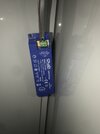I’ve got a twin and earth mains cable providing input into an LED driver. The driver sits on top of a kitchen unit and I then have a 3 core flex that goes behind and down the kitchen unit into a JB that is screwed to the bottom of the unit. The 3M LED tape is connected and powered from this JB.
My questions:
1. The driver only has terminals for L and N. How should the CPC be terminated on both ends?
2. When using my 2 pole tester on the 12v terminals of the driver, it detects power when the circuit is energised but when I denergise it, the tester continues to report 12v and very slowly goes down in voltage. Whereas the mains terminals are either on or off depending on whether the circuit is energised. What’s the cause of this?
Thanks in advance.
My questions:
1. The driver only has terminals for L and N. How should the CPC be terminated on both ends?
2. When using my 2 pole tester on the 12v terminals of the driver, it detects power when the circuit is energised but when I denergise it, the tester continues to report 12v and very slowly goes down in voltage. Whereas the mains terminals are either on or off depending on whether the circuit is energised. What’s the cause of this?
Thanks in advance.


